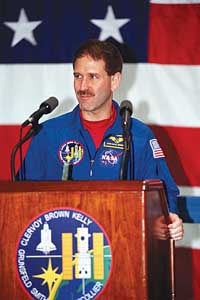Alumnus John Grunsfeld is ‘natural selection’ to be NASA chief scientist
By Steve KoppesNews Office
 John Grunsfeld |
As a veteran of four space flights, Chicago alumnus and astronaut John Grunsfeld has logged more than 45 days in orbit, including 37- and a-half hours of space walks.
“That’s supposed to be one of the most arduous tasks you can have as an astronaut because it involves being in a suit for long hours,” said Simon Swordy, Professor in Physics and the College, about Grunsfeld’s work. “He’s the kind of guy who can do that because he always had a great sense of purpose.”
Now Grunsfeld (Ph.D.,’88) will bring that sense of purpose to his new job as chief scientist of the National Aeronautics and Space Administration.
As chief scientist, he will serve as the principal science adviser to NASA administrator Sean O’Keefe and as the agency’s liaison with the national and international scientific communities.
“John has a deep interest in astronautical science and has the hands-on experience to back up what he has taught in the classroom,” O’Keefe said. “With his background in physics and astronomy, John is a natural selection to direct NASA’s important space-based science objectives.”
Grunsfeld based his Ph.D. dissertation on data from a Chicago experiment that flew aboard the space shuttle Challenger in 1985. The experiment, designed by the late Peter Meyer, Professor Emeritus in Physics and the College, and Dietrich Müller, Professor in Physics and the College, was constructed at the Enrico Fermi Institute and nicknamed the “Chicago Egg” because of its University origin and its shape. The data from the experiment remain the most detailed ever obtained on the composition of cosmic rays at extreme energies, Müller said.
Swordy, who has known Grunsfeld since the latter’s graduate student days, said Grunsfeld is the kind of person who likes to make up his own mind about issues.
“Even if there were some already existing general opinion about something, he would go find out the facts himself and then make his own decision about what he thought,” Swordy said. When Grunsfeld disagreed with the way things were done, he would diplomatically present alternatives.
“When you’re doing science, it’s not always clear what’s right and what’s wrong and what you’re supposed to do next,” Swordy said. “He always was the guy kicking around some new ideas or saying, ‘well, maybe we should try doing it some other way.’ ”
Following his Ph.D., Grunsfeld received the University’s first W.D. Grainger Fellowship in Experimental Physics. When he left Chicago in 1989, he became a postdoctoral scientist in the astrophysics research group of Tom Prince (Ph.D.,’78) at the California Institute of Technology. Prince, incidentally, in 2001, became chief scientist at the Jet Propulsion Laboratory, which undertakes NASA’s robotic explorations of the solar system.
While Prince was finishing his studies at Chicago with Müller as his advisor, Rochus Vogt (Ph.D.,’61), once a student of Meyer, served as interim chief scientist of the Jet Propulsion Laboratory from 1977 to 1978, and Ed Stone (Ph.D.,’64) was its director from 1991 to 2001.
“That’s quite a heritage,” Müller said.
In 1999 and 2002, Grunsfeld took part in five space walks to upgrade the Hubble Telescope. “Servicing the Hubble Space Telescope is far and away the most meaningful thing I’ve ever done,” Grunsfeld said. “It’s helping us answer fundamental questions about our world and our place in the universe.”
Grunsfeld once told reporters at a press conference that his experience with the scientific balloon group at Chicago helped prepare him for working with the Hubble Telescope.
“In this group you get hands-on experience of not just deriving scientific results, but figuring out what instruments don’t work, how to fix them and how to work with electronics,” Swordy said. “In this day and age, this is something of a dying breed because many scientists today just sit at computer terminals. They don’t have the kind of hardware experience that John has.”
Like Grunsfeld, Vogt and Prince also worked on balloon projects as students at Chicago. Stone, meanwhile, worked with the late John Simpson, the Arthur Holly Compton Professor Emeritus in Physics, on developing instruments for satellites.
“Students who work here on these instruments get an extremely good all-around education in my opinion,” Müller said. It gives them an opportunity to develop their own project, from design and construction to field management and data analysis.
![[Chronicle]](/images/sidebar_header_oct06.gif)